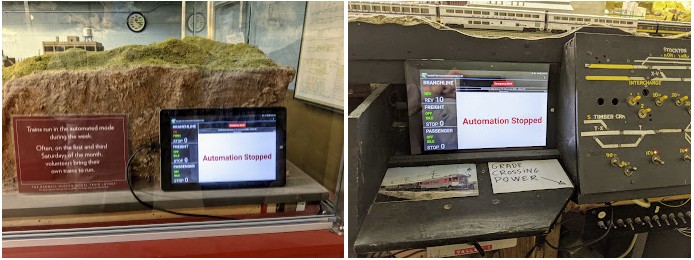The Randall Museum in San Francisco hosts a large HO-scale model railroad. Created by the Golden Gate Model Railroad Club starting in 1961, the layout was donated to the Museum in 2015. Since then I have started automatizing trains running on the layout. I am also the model railroad maintainer. This blog describes various updates on the Randall Museum Model Railroad and I maintain a separate tech blog for all my electronics & software not directly related to Randall.
2021-06-26 - Work Update and a look at Buildings Lighting
Category RandallI reinstalled the tablet displays on the layout, preparing for an eventual reopening of the museum:
Allen got a “Cracker Jack” illuminated HO-sized billboard, so we’re trying it out to see where it would look nice on the layout; here’s Allen first idea and it seems like a good option:
(Edit: And here’s an update on how I think these work and how I managed to ruin the electronics for that one by using the wrong voltage to power it, so now I’ve ordered a full replacement and I’m waiting for it; they also sell replacement controllers.)
I think we should power it from the building lighting circuits (see below). So I had to dig a bit into it. The building lights are controlled by a row of unlabelled toggles under the Valley panel:
Not only are the toggles unlabelled, but the wires are quite hard to follow, as I had tried to do a few years ago and put aside. I’d be interested in finding which buildings have power and fix them as needed, and Allen seems motivated to work on that too so we may get somewhere here. (Edit: I have posted an update on the Building Lighting Panel here.)
The power for the building lighting comes from this old-school rock-solid power supply.
I’ve just measured it at 9.3 V, which is good. That means it will adequately power 12 V bulbs yet would extend their lifespan by avoiding overburinging them. It also means we could power something like Allen’s billboard using a small Buck Step-Down Converter.
Similarly I realize the Motel neon sign, the Theater neon sign, and the fire truck exhibits all use old Bachman DC track power packs to be powered and could be fed either directly by the Building Lighting circuits, or via a small voltage converter. It’s interesting to realize that all these modern additions were hastily done and used power supplies literally hacked together (there are 3 DC track power packs to power these, hastily placed on a little shelf support with a power strip under the layout). If only the person who had spent time doing that had also spent a few more minutes or hours, they would have powered it from the Building Lighting power supply that seems to have been rock solid since 1997.
Task wise, my priority is to install that new billboard. Before we look at the rest of the building lighting, I do have another set of tasks I want to deal with. The ideal strategy is to interleave them -- with the idea that we fix one thing for the layout that is not public visible yet we need for running / automation, and then alternate with a fully visitor-oriented task like the lighting or my ongoing Train Motion project.




